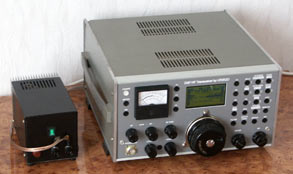
the t changes from 0 to PI during the rise and from PI downto 0 during the fall. On the next figure you can see the simulated envelope rise shapes for the different settings of the rise/fall time.

The CW is generated by the DSP unit at the second IF (16 kHz). The block diagram of the CW exciter (implemented in DSP software) is shown below.

The delay line is included in the keying path to cure the problem of the first element shortening when using semibreak-in. The amount of delay is equal to the transmitt-receive switching time, this also prolongs relay life.
The shape of the CW signal envelope should be choosen very carefully. I used
the following rise/fall shaping:

the t changes from 0 to PI during the rise and from PI downto 0 during
the fall. On the next figure you can see the simulated envelope rise shapes for
the different settings of the rise/fall time.

I found that the best rise/fall length (good sounding without clicks) is 5ms (represented by green line). This results in a CW signal with rapidly falling sidebands and very good shape (and no clicks!).

The spectrum of the CW signal at 60WPM. You can see, more then 80dB CW signal sidebands suppression outside the +/- 300 Hz region. This spectrum was obtained from the signal at 16kHz IF, but since the following transmitter stages are linear we can safely assume that the RF signal will have almost the same spectrum.

The envelope shape (5ms rise/fall) at the 80m band. The horisontal scale is 10ms/div.

The same as previous picture, but horisontal scale is 1ms/div.

 Made in Ukraine
Made in Ukraine